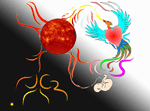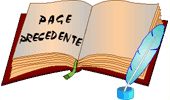«Why are we in this world ?
To learn... and have fun.» Richard Bach. (The Reluctant Messiah.) |
The birth
of the healthy mind.
of the healthy mind.
4 - The child's way of thinking before the age of 4 :
A - The conditions of learning - Immaturity of the brain :
In the animal kingdom, "precocious" species, such as chickens, depend on innate abilities and therefore mature quickly.Similarly, in the marine environment, genetic adaptation capacities are particularly well developed, so that sea turtles know, as soon as they leave the egg, what behaviour to adopt.
On the contrary, other species with a family structure depend on learning from adults.
This social learning, which began in the animal kingdom long before the appearance of man, indicates that the animal is aware of the actions of others.
Thus crows and ravens have a coherent understanding of their physical environment, they live in complex social groups, in which each individual has access to what is going on in the minds of others. Thanks to this, they become capable of innovative behaviours, such as the Caledonian crow, which is able to make and use tools to search for food. It can be observed cutting hooked sticks from hard leaves or branches. With these tools, it can dislodge beetle larvae in tree holes. This behaviour, which is difficult to assimilate and put into practice, is passed on from generation to generation.
For this reason, the chicks are dependent on their parents for much longer than the chicks.
This long period is required by the complex social adaptation (which imposes a permanent readjustment), to rules of behaviour sometimes incompatible with those of biology.
This is why we cannot speak of immaturity, but rather of a long period of construction and organisation, and this period of internal construction is based on the model that operates within societies.
The brain of children is very different from that of adults. It has more inter-neuronal connections which will be gradually suppressed or reinforced according to their frequency of use.
This phenomenon allows memorization and reinforcement of learning. However, it reveals a weakness, because it depends on the cultural environment : erroneous knowledge can then be retained.
It should also be noted that the immaturity of the child and its ability to learn go hand in hand with the immaturity of its prefrontal cortex, which will not be completed until it is about 25 years old. Thus, the child could well be considered mature when he has lost his capacity for innovation, i.e. when he has learned everything and retained the knowledge deemed necessary by his group.
During this period, the child is vulnerable. Evolution solves this problem by a division of labour between babies and adults.
During this period of construction and organisation, the absence of control by the prefrontal cortex is a considerable advantage for learning in young children. Indeed, while individual functionings have slowly settled over millions of years and through the development of brain size, the development of societies is too recent a phenomenon to have been able to profoundly reshape brain structures. The new brain functions that social development imposes could not be saved in the gene pool. Learning, which develops the connections between neurons [cf : memorization- in french] is therefore indispensable.
It is these new connections that will enable the prefrontal area to inhibit irrelevant thoughts and actions, in particular those that do not conform to the requirements of the community.
Yet it is also because of the absence of inhibition that babies and young children can freely explore their environment. This is because the child is naturally 'awake', open to the world, and without preconceived ideas about it.
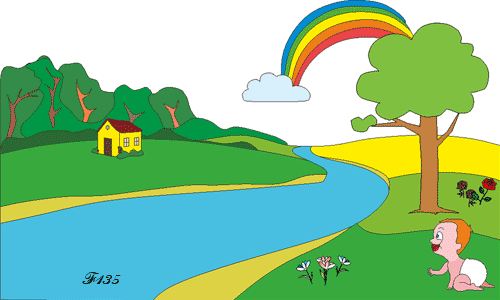 |
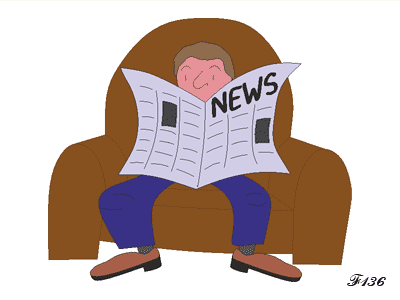 |
The child and the adult, two ways of discovering the world.
Let's ask ourselves about the natural capacities that a child has before learning disrupts an innate functioning.
B - Natural abilities (Physics, Biology, Mathematics) :
a - An innate grammar :We will not go back over this capacity mentioned earlier [cf : A universal grammar]. Let us simply recall that, from the age of two, the child can recognise a noun or a verb in a sentence, and discover by himself the meaning of words.
b – An intuition of mathematical laws :
Even if toddlers have not acquired a perfect command of language, it is possible to use language to probe what they are thinking.
Contrary to what was imagined before the mid-1980s, scientists have discovered that babies already possess a great deal of knowledge about the world around them : simply asking them to make choices yields a lot of information.
Researchers discovered that their knowledge goes far beyond immediate sensations.
For example, while Piaget concluded that a child acquired numbers at the age of seven, we now know that as early as four months of age a baby is able to add 1 + 1 = 2 or subtract 2 - 1 = 1.
What was attributed to education is in fact part of the child's innate abilities.
c – An intuition of physical laws :
In addition to this mathematical logic, psychologists have been able to demonstrate that the infant has an intuition of the physical laws that govern the reality of our world. Immediately, he will scrutinise the new situation to integrate it into the knowledge he had previously acquired.
Thus, a character who walks through a wall will attract his attention more than one who respects the laws of physics.
Without yet knowing the world around him, he already has the knowledge of what is consistent with reality.
Thus, the belief that an object can pass through a wall would be a "magical acquisition" brought and reinforced by adults through fairy tales and, today, fictional films. If the child knows the difference between the magic tale and reality, it turns out that, as an adult, he or she may no longer be able to distinguish between them.
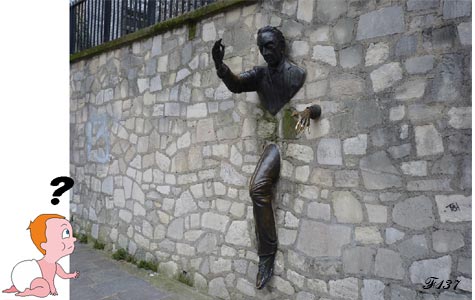
Le passe-muraille, place Marcel Aymé (Montmartre)
d – An intuitive perception of the laws of the living world :
Their intuitive knowledge does not stop at the laws of physics alone. From the age of 3 or 4, children also have elementary notions of biology : they begin to understand what it means to grow up or to be sick.
Again, when they reason about situations, they go beyond what their perceptions tell them.
But the most important knowledge for babies and young children comes from others. It will enable them to integrate into the family group, then the social group, and enrich them with the group's knowledge, whether or not it conforms to reality.
Just as everyone has seen that newborns are capable of imitating the facial expressions of their counterparts, researchers have also shown that they already understand that people are different from one another.
Gradually, their knowledge will grow, and from 18 months onwards they will even be able to understand that two people can want different things.
It has been found that babies from 14 months onwards always give their mothers sweets if they like them. From 18 months onwards they will give mum what she likes best.
This behaviour develops without any education, and it coincides with the appearance of empathy : the baby feels what pleases, and knows how to distinguish between its need and that of the other.
« At 14 months, the baby gives what he likes,
At 18 months, he gives the person what he or she likes. »
At 18 months, he gives the person what he or she likes. »
From the age of four, the child distinguishes reality from fiction, physiological behaviour from aberrant behaviour. He will even be able to explain that a person is behaving in a strange way because he believes something that is not true.
The child thus has an intuitive logic, very different from that of the adult, who often only has the logic of cultural knowledge: washing powder has blue grains, "therefore" it washes whiter; it is in a smaller box, "therefore" it is more concentrated.
However, this very ability to understand and adapt to the world will quickly lead him/her to understand that, in order to avoid conflicts, it is better to accept adults' assertions, even if they do not conform to reality.
C – Learning materials :
A question arises, however, which is difficult to answer.How can human beings acquire relevant knowledge about the world when they are constantly confronted with a mass of often contradictory sensory information ?
a - The senses :
We have seen the importance of the senses [cf : the unconscious, that unknown - in french], each of which allows us to approach a part of reality and, all together, complement and reinforce each other to maintain inner balance (homeostasis) and relations with the outside world. Without them, there is no learning, and if they are altered, following a lesion or voluntary inhibition, learning will be reduced accordingly.
b – Pre-established capacities :
1 - Statistics :
We know that the human brain uses statistics [cf : the probabilistic brain - in french] : this is an inheritance that the child has immediately.
This explains why he chooses the answer validated by the greatest number : thus, in a closed religious or political environment, the child will adopt the dominant belief or behaviour.
However, even animals are capable of 'forgetting' their old knowledge and developing new knowledge when their environment changes. For example, blue whales now sing in a lower key than they did in the 1960s, even though their 'silent world' has lost its silence. Why should this not be the case for humans ?
Detecting statistical regularities is the first step in scientific discovery. Today, it also allows robots to develop their knowledge of the environment.
It is from these same statistics that children, like scientists, will draw conclusions about the world around them.
Having partially failed to develop intelligent machines, researchers wondered how children became intelligent and learned to predict changing circumstances. They then developed programs that allowed the machines to learn by themselves, programs that used Bayes', so-called "probabilistic" model.
Because, just like children, machines must learn to predict the evolution of environmental circumstances in order to adapt more quickly.
It is this approach to learning in robotics that has made it possible to better understand how the "brain-computer" in children's heads works.
To do this, the researchers have combined complementary techniques, with two main ideas :
- First, mathematics will allow the description of the hypotheses that children can make according to what they see or hear.
- Secondly, these hypotheses will be associated with the probabilities of occurrence of different events.
The hypotheses that best describe the data then become the most probable [cf : Statistics in plants].
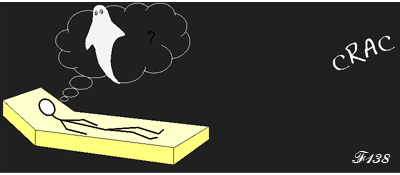
" What is this ? A ghost ? "
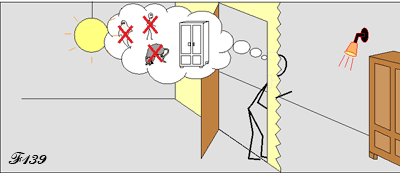
" There is no such thing as a ghost !
It's not an intruder, nor a rat…
So it's the wood in the cupboard that's drying out ! "
It's not an intruder, nor a rat…
So it's the wood in the cupboard that's drying out ! "
For the human brain, logic does not always lead to a precise and reproducible result as it does in mathematics.
This is why statistics are essential to determine which result comes out most frequently... This is the one that will become the most probable and will be retained by the child in the following events...
... Until this result is discarded by a new data !
Thus, the appearance of Father Christmas will prove to be logical since it always occurs on the same date and is always accompanied by gifts...
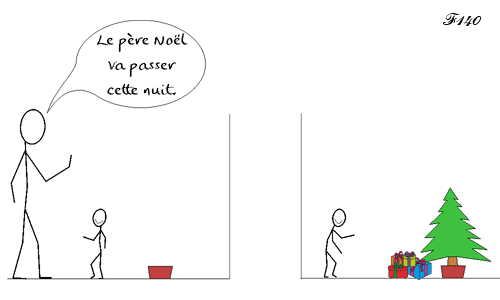 |
Until a new piece of information tells the child that Father Christmas does not exist !
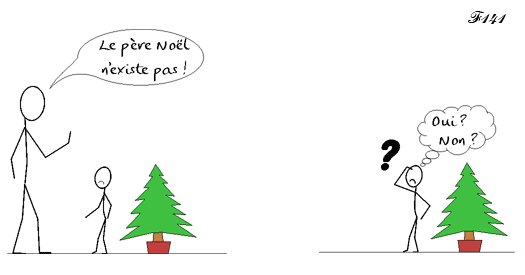 |
However, this information will not necessarily be decisive, it will leave a doubt until it has been confirmed by various and multiple sources. It is only when the new information is more widespread than the first that it will be retained as the most probable, until the initial information disappears definitively.
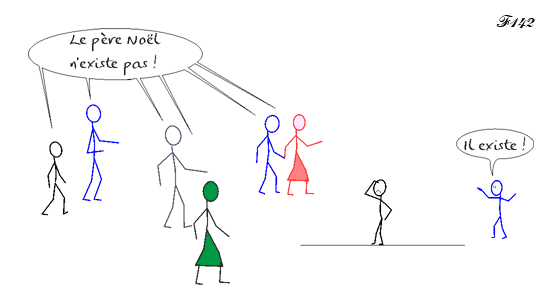
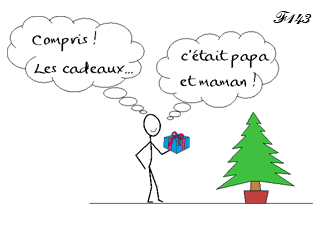
The majority determines the certainty.
This new knowledge will have the merit of teaching the child that adults do not necessarily provide reliable information. He will learn to check what seemed obvious and will refine his critical thinking.
The importance of the number of opinions and answers obtained on the child's development is clear.
A child who has lived in an environment closed to any opinion other than the established rule will imagine that he or she can reach paradise or take over a territory by violence.
Just as consciousness depends on the multiplicity of the senses, it also depends on the multiplicity of different opinions, and only then will the child be able to make an informed choice. Only then can the child make an informed choice. It cannot be learned through a single piece of information.
However, these statistics do not give rise to an exact result, they only allow the development of hypotheses that will have to be confirmed.
It is therefore without being aware of it, but by using such statistical analyses, fed by a wide variety of information, that children can be more successful than adults when it comes to considering a new hypothesis [see : origins].
This innate programming of the child's brain, all geared towards discovery, makes babies not only born scientists, but also true sages.
Conversely, children change their implicit approach and become less creative when they are taught things. Why make the effort to find an answer if it is provided without effort ?
The child left to his own devices develops his intelligence more than the one subjected to formal education. His creativity will distinguish him from those who have been frozen in the collective mould.
« In the field of knowledge, and in the absence of proof,
the majority determines certainty.
Only the critical mind determines consciousness. »
the majority determines certainty.
Only the critical mind determines consciousness. »
2 - Number sense :
In 1992, Karen Wynn, from Yale University (USA), shook things up when she published a paper in the journal Nature entitled : "Addition and subtraction in the human baby".
In experiments in which objects or characters appear and disappear, she was able to observe that the child can count them even before it has integrated the learning of numbers (six years according to Piaget).
She was thus able to demonstrate that babies have a sense of numbers from the age of four months, carrying out elementary additions and subtractions: 1 + 1 = 2 ; 2 -1 = 1.
She also determined that they are able to detect mathematical errors.
Even before rational consciousness has had time to build up with life learning, what we call the 'unconscious' appears to be quite capable of observing and taking account of what it sees.
This is the beginning of cognitive reasoning.
Like human babies, other primates do not need to communicate to understand their environment, and mathematical language seems to appear in nature even before elaborate language. Indeed, when it comes to assessing the number of predators and the resulting danger, vision and calculation come into play long before the information is transmitted to the community.
However, in order to move from the stage of 'evaluating' a quantity to calculating the quantity, the infant will have to inhibit the perception of 'length = number'.
We have seen that while the child evaluates differences in length very well, consistent with a given number of tokens, he or she may make mistakes when a shorter line contains more tokens [cf : calculation - in french].
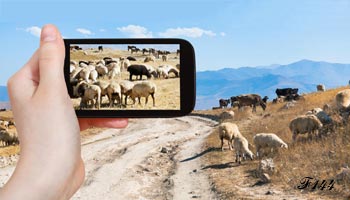 |
 |
For the walker, the assessment is sufficient. |
For the herder, calculation is necessary. |
At the cerebral level, the prefrontal cortex seems to be at the origin of this control and inhibition process.
By acquiring numbers and the ability to inhibit, the child acquires the age of reason.
«To develop is to acquire new knowledge
by inhibiting old knowledge.»
by inhibiting old knowledge.»
3 – Numerical skills :
The origin of numbers in children :
Mathematics is not limited to the manipulation of numbers. It is, as we have seen, a real language [The language of numbers - in french].
However, a baby's innate numerical abilities do not yet give it access to numbers. At most, they allow them to compare small quantities. It is this same ability to compare that will, for example, enable the female animal to see that one of her young has moved away, or to determine when the number of predators is a sign of danger.
Before the child can count, the number, for him, corresponds above all to a sensation, here of a visual nature. Later on, the numerical sequences in everyday language and children's rhymes will link this sensation to numbers. Little by little, the sequences of words "1, 2, 3..." will also take on meaning.
This visual ability to compare can be linked to the other senses : more smell or more noise will correspond to "more numbers".


Stanislas Dehaene, working on number intuition in humans and animals, has shown that it involves the circuits of visuospatial representation in the brain.
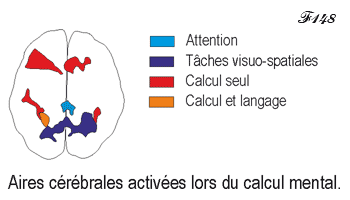
Of course, these are only simple operations. For example, if the operation 10 + 5 equals 78 is proposed, we immediately know that the result is false because the difference between the two terms of the equality is too large.
This gap is easily illustrated by representing the number on a number line.
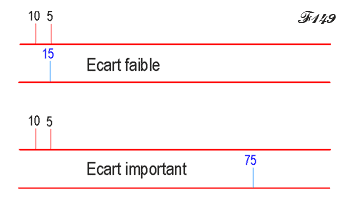
The same ability to represent the number approximately is used to visualise the difference between a field and a garden.
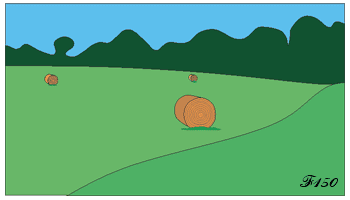 |
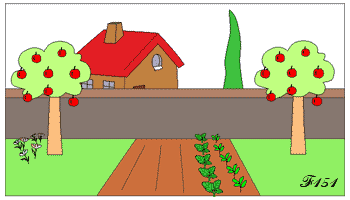 |
Very young children, even before they have learned the number symbols, are able to combine values, compare them approximately, add and subtract them.
In his book "La bosse des maths" https://www.youtube.com/watch?v=0yCWPAelZBo, Stanislas Dehaene tells us that he was able to observe through brain imaging that people who performed an approximate calculation activated a particular region of their brain : the intra-parietal sulcus, a region affected by number sense. This observation validated the existence of "number neurons". Even in babies, this region of the brain is activated by the approximate observation of sets of objects.
This approximate representation of quantities is an evolutionary legacy and is now the basis for learning mathematical symbols.
Knowing a number is therefore not simply designating it by a vocabulary term, but understanding that it exists by reference to another smaller or larger number, i.e. by adding or removing a unit. Two is 'one' to which 'one' has been added. By successively adding "one" to the previous number, the child gains access to the sequence of numbers : he or she becomes capable of counting.

By using these concrete quantities, the child will gradually assimilate the abstraction that is the number. A number, represented by an abstract sign, cannot be perceived by the senses : only the concrete object allows a numerical value to be assigned to it.
By gradually building up the concept of number, the child will develop the ability to compare the number of different objects. This is what will enable them to give meaning to numbers. For example, the number 2 corresponds to two hands and two eyes, the number 5 to the fingers of the hand, etc. .... A bicycle has two wheels, a car has four.
Still by analogy, he will then generalise the idea of number and understand that the number refers to a quantity.
Neuroscientists have been able to show that the representation of Indo-Arabic numbers depends on the visuospatial skills of the brain, which the child begins to develop very early thanks to its ability to reason by analogy.
As the child begins to assimilate symbolic codes, he or she becomes capable of reasoning beyond material considerations. They can then discover mathematics with numbers alone, just as they discover the objects around them with the words printed in books.
The sense of numbers is first individual, it makes it possible to determine a vital quantity (food, predator); it is in a second time that language intervenes, making it possible to name the object and to share it (orange, sheep). The living being moves from sensation to abstraction.
In a third stage of evolution, language will give rise to the idea of number and the symbol associated with quantity in order to share precise quantities (1kg of oranges, 125 sheep...).
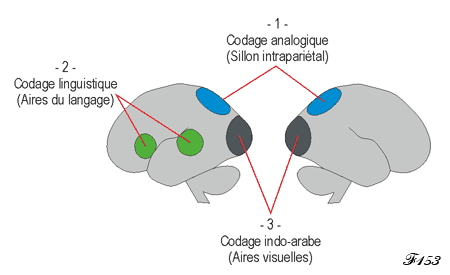
The analogical representation of quantities, located in the intraparietal sulcus, allows approximations.
The linguistic representation allows us to read, hear and produce numbers. It calls upon the language areas.
The Indo-Arabic representation allows the reading and writing of number symbols. It involves the visual areas.
The linguistic representation allows us to read, hear and produce numbers. It calls upon the language areas.
The Indo-Arabic representation allows the reading and writing of number symbols. It involves the visual areas.
Are we all equal when it comes to mathematics ?
At the beginning, this "intuition" of numbers is common to all : there is no difference between girls and boys, but it will be progressively refined according to the education received.
Thus, a small child will know the difference between 4 and 8 objects (i.e. a quantity that goes from simple to double).

Then, little by little, he or she will learn to tell the difference between 4 and 5, thus refining his or her ability to understand the difference between two numbers. However, not all children will develop this ability at the same time.

Physical expression, the importance of which we have seen [cf : learning through gesture - in french] is inseparable from calculation. More precisely, it is a question of determining the facial expression that accompanies the spatialization of numbers. Everyone can experience this: ask a subject to add two numbers in his head, and his gaze will go up and to the right.
Conversely, ask them to subtract, and their gaze will go down and to the left!
In 2008, the Saclay team revealed this mystery.
Indeed, as learning progresses, the area devoted to approximate numbers (the intra-parietal sulcus) is no longer sufficient. Other regions will be recruited. In this case, it is the area devoted to eye movement that is called upon, which explains their movements. "This is what Stanislas Dehaene has called "neuronal recycling". Looking to the right for an addition and to the left for a subtraction would be linked to the numerical line of representation of numbers, mentioned above, which would impose these movements.
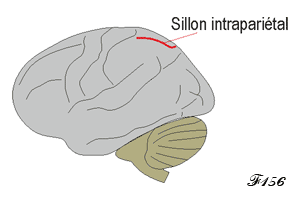
These stages of number acquisition range from 3 months to 12 years.
4 – Linguistic abilities - The neurons of reading :
For the same reasons of proximity between cerebral areas, Professor Stanislas Dehaene was interested in the neurons of reading. Indeed, a paradox exists in this field.
The study of evolution shows that the human brain took hundreds of thousands of years to develop :

As for the acquisition of reading, it is very recent. It was preceded by the appearance of drawing and writing, but for a few thousand years only scholars were concerned. Large-scale reading has only existed in humans for a few centuries.
How did a cortical area dedicated to reading emerge so quickly ?
It seems that, here again, "neural recycling" intervened.
In inventing writing, man did not create a new cortical region dedicated to writing, but simply exploited the plasticity of his neurons, which are capable of changing function according to need : this is how a small part of his visual system, which had previously been used to recognise objects, became specialised to recognise new shapes.
In children, learning to speak teaches them to make the connection between what they see and what they hear. Later, learning to read teaches them to make the connection between what is expressed in speech and what is represented by signs. It is this learning that will allow part of his visual areas to connect to the areas of spoken language.
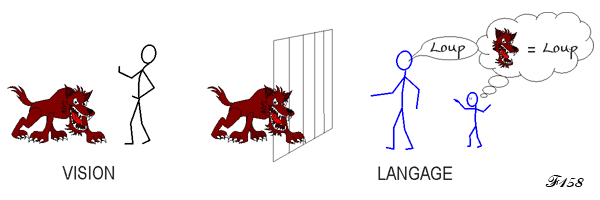
Language development.
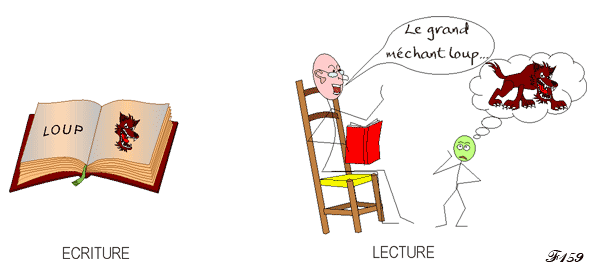
Development of writing.
A study carried out by Stanislas Dehaene's team on 60 illiterate people showed the evolution of the brain areas of these subjects as they learnt to read : while an area specialising in reading developed, the researchers noted a decrease in face recognition [cf : Learning to read].
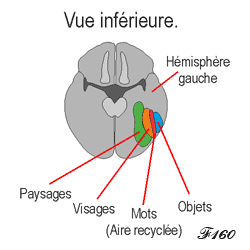
In this way, we find once again in the brain neurons, the capacity that all evolved animal species have to reorganise their skills according to new circumstances..
5 – Alliance of numbers and language - the importance of inhibition in the acquisition of word meaning :
While today some people still only know how to count 1, 2, 3 and many, the development of societies has imposed two evolutions : that of language to communicate, and that of numbers to adapt new values to new collective needs.
We now know that babies have an innate sense of numbers that enables them to accomplish approximate tasks.
How then can we explain the fact that Jean Piaget observed discrimination errors in the recognition of numbers in children who spoke, up to the age of six ?
The child learns to speak around the age of two. At two and a half years of age, they begin to say the words for numbers, indicating that they are beginning to do calculations and are able to relate the word to the number.
Language does not have a founding role in number sense since numerical evaluation already exists in the child before he can speak, it only allows him to acquire the notion of exact number.
However, if language seems necessary to acquire this notion, it can pervert the accuracy of perception.
Indeed, before the age of two, the child does not make mistakes when evaluating differences in length if these are consistent with the difference in numbers.
During the transitional period that follows, he makes errors that did not exist when he was using his visual-spatial intelligence, which is faster, more fluid and less costly from a cognitive point of view.
To understand the origin of these errors, the researchers conducted a study asking children to respond verbally (instead of measuring gaze time) : the children had to say whether the situation presented was right or wrong. The two-year-olds were wrong and considered the addition 1 + 1 = 3 to be right, for example, whereas their five-month-old counterparts did not make this mistake. However, this error was only observed in French-speaking children and not in English-speaking children of the same age.
Olivier Houdé and his colleague Peter Bryant from Oxford University were able to propose an explanation based on a linguistic difference. In French, the number "1" is pronounced like the article "un", which requires a longer learning period for the child, which is not the case in English, where the number "1" is pronounced "one", and the article "un" is pronounced "a".
Human babies, like great apes, have a brain without elaborate verbal language. For this reason, it is understandable that it is difficult for an adult to analyse a dream that is expressed with images and not with words. The same difficulty is experienced when it comes to communicating with a deaf-mute.
Today, if it is possible to understand how we go from numbers to language, and if it is possible to understand how we reach intelligence, one question remains : how do we go from genes to intelligence ?
D – The means of learning :
How does the child discover the world around him ?a - Handling objects :
Observation of children suggests that when they play spontaneously, "touching everything", much to the annoyance of their parents, they explore the consequences of their actions, and study the cause and effect relationships. Like researchers, they experiment, which is the best way to discover how the world works.
Thus, when they manipulate an object, what they like most is to discover.
In one study where a machine had two levers, a group of preschoolers were shown a duck that appeared when one of the two levers was operated, and a puppet when the other was operated. A second group was only shown that both toys appeared when both levers were operated at the same time. Then the children were left to play.
The children in the first group, who already knew how the machine worked, played with it much less.
The second group, confronted with an unknown, played with the machine for a longer period of time in order to discover the role of each lever.
b – Experiments :
Babies do not experiment and consciously analyse statistics like adults.
Adults explore using their own experience and that of others. Babies, on the other hand, explore by trial and error, as they do not yet possess the knowledge, but only the means of discovery, without being misled by preconceived ideas.
In the same way, adults like to go further and further into knowledge, often seeking to create new situations to find new answers, even if these answers are not vital.
Their motivations are different : it may be the lure of gain, or the desire to be the initiator of the discovery of an unknown world. In many cases, the competition will motivate him.
The child does not have these needs. he will only be interested in a new situation.
The child's brain can be compared to a kind of computer developed by evolution and constantly fed by experience.
In this sense, all the machines invented by researchers show how open-minded children are: before the age of four, they understand how they work much more quickly than adults.
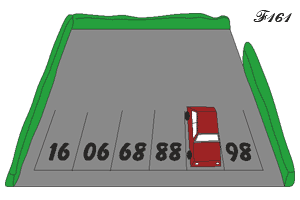
Find the number of the place where the car is parked,
and don't go looking for the result straight away.
and don't go looking for the result straight away.
Thus, the cognitive abilities of babies and young children are now proving to be far superior to those that psychologists have long attributed to them. If they are dependent on adults for so long, this period is used to acquire impressive cognitive abilities, such as learning and creativity.
This innate programming of the child's brain, all geared towards discovery, leads one to believe that babies are both true scholars and true sages..
In the field of learning, the child therefore excludes any arbitrary acquisition. This only comes into play secondarily, when he finds neither an explanation nor a solution to a problem, whereas curiosity requires him to find an answer.
c – Dead ends :
This is how, when he tries to solve a new operation, he may not succeed. He will then use the deadlock method and continue to solve the problem without taking into account the part of the procedure that blocks him (described by Kurt Van-Lehn, Massachusetts Institute of Technology - 1980).
This strategy allows him to propose an answer, whether it is correct or not ! In doing so, he simply exploits his previous knowledge : for example, if he has not learnt to carry an addition, he will do the operations without carrying a carry.
This may be a learning defect, it is not a sign of immaturity.
It turns out that what is wrong in terms of calculation turns out to be a perfectly suitable reaction in the field of survival. An animal that cannot find a way out of danger will flee, even if the game is lost.
The fact that the child continues to solve the problem, even if the learning process is still incomplete, shows that he or she is looking for solutions, and exploits them without hesitation, even if it means correcting them later.
Conversely, the adult is blocked if he or she misses a single piece of information about the problem.
This mode of reasoning can be found in dreams. We remember the « Chinese dream - in french» : the movement of flight, towards the place which is a dead end, is repeated until an unforeseeable solution arises and proves viable.
This dream indicates that, in danger, reasoning must give way to the instinctive impulse that can allow one to escape one's fate.

The dreamer knows that escape is impossible........ He tries anyway........ and everything becomes possible.
This dream demonstrates that unconscious functions, although they may seem aberrant, are complementary to rational functions.
It also shows that we can at any moment "skip" an insoluble situation to move on to another... Simply because life goes on !
It is not because reason has a logic that imposes the continuity of reasoning, that the unconscious must conform to it. On the contrary !
If it has no say in the daytime, it leads the game at night, and the rules it employs are very simple ; they are those of a child of less than three years old who does not complicate his life with the advice of Lady Reason.
d – Analogy, the basis of learning :
Generally speaking, we deal with new situations by relying on our previous knowledge : this is called analogy. The child does not escape this way of thinking.
Thus, when he learns, he makes the best compromise between :
- what he perceives (for example the earth is flat)
- what he is told (the earth is round)
- and what he knows elsewhere (a ball is round, a larger ball has a flatter surface) which will serve as a support for assimilating the new information.

Thanks to their knowledge, everyone can find the analogy between the structure of the atom and that of the solar system.
The same applies to the activity of the unconscious mind during a dream. When it creates a situation, it creates an analogy.
Thus we could cite the discovery of the structure of the atom by Niels Bohr [cf : The field of intuition.].
However, this analogy is only a method, not a representation of reality.
Similarly, photons can be both represented as balls and calculated as waves. While these representations facilitate understanding and operation, they do not allow us to imagine them as anything other than two different forms.
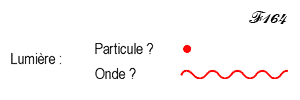
Let us return, once again, to the dream of the man pursued by the Chinese.
In reality, the dreamer was in an insoluble situation. By leading him, through the dream, into an impasse, his unconscious showed him that the solution was on the side that seemed impossible.
Thus, it was thanks to his dream, or rather thanks to his unconscious, that new solutions appeared, first in his dream, then in his life. The dreamer was able to transpose the solution of his dream into reality by acting differently than he had planned.
Thus, the unconscious often uses analogies to show that the most unpleasant solution turns out to be the easiest. Where reason sees an impossibility, the unconscious can see a solution.
In the following dream, the subject has to cross a river.
Logical behaviour dictates a diversion via the bridge.
Logical behaviour dictates a diversion via the bridge.
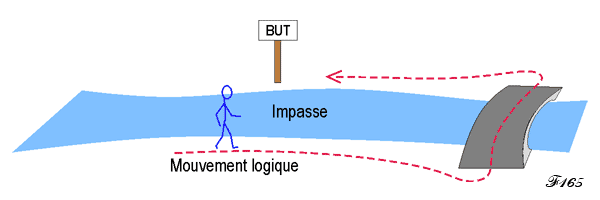
It is then that an unexpected event occurs, imposed by the unconscious : a lynx blocks the road.
The subject becomes frightened, loses his balance and falls into the river. He then discovers that the river is dry, and he can cross safely. He did not get wet or tired walking to the bridge.
The subject becomes frightened, loses his balance and falls into the river. He then discovers that the river is dry, and he can cross safely. He did not get wet or tired walking to the bridge.
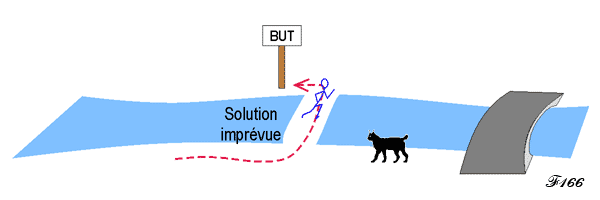
e – Attention - How do we know that the child is conscious ?
In the past, how was the existence of consciousness established in children ?
Thirty years ago, the notion of attention was unknown, and most psychologists, philosophers and psychiatrists thought that babies and young children could not differentiate between the real and the imaginary. They were merely unfinished adults.
Thus, Jean Piaget concluded that children's thinking is irrational, egocentric, that they are locked in the moment, and that they do not yet establish the relationship between cause and effect.
Why these conclusions ?
- First of all, they are linked to the fact that the child barely speaks and has difficulty expressing his thoughts.
- It was also a time when the notion of difference was confused with that of superiority (of culture, civilisation or race)
- On the other hand, researchers, who ignored the possibility of children learning on their own, held to the notion of an unfinished brain in children and a finished one in adults [cf : artificial intelligence].
- Moreover, the children Piaget studied had not yet acquired the rigorous concept of cause and effect, as their knowledge and conclusions were challenged with each discovery.
- Finally, as an adult, Piaget lacked the skill to communicate with children, i.e. to listen to them and decode their language and attitudes. Indeed, the child's register is that of sensitive perception, whereas the adult has a different logic, acquired to integrate the relationship with the group.
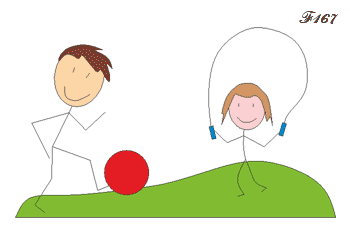 |
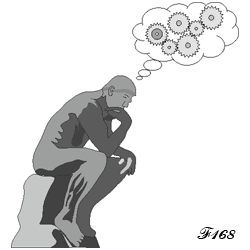 |
The child lives in the present and can explore and experiment. |
The adult thinks of all the things he or she has done and could do. |
The adult's difficulty in determining the child's level of awareness is due to the loss of ability to communicate through sensitive perception, and the negative judgement of anything different.
Caught up in the responsibilities of daily life, the adult forgets what he or she felt as a child and believes that the child feels little.
Thus, he was able to deduce that any being that does not speak is not endowed with consciousness...
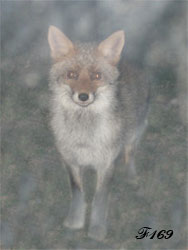
Fortunately, science is now taking a new look at the world, and shares this look with us.
Today, how do we judge whether a child is conscious ?
If speech is not yet accessible to the child so that it can reveal its conscious capacities to researchers, it already possesses the universal language of gestures and body expressions.
So what do researchers see when they determine that the child is conscious? His body freezes, while he becomes attentive to the scene unfolding before his eyes.
But it was not until the late 1970s that researchers became interested in what babies and young children do, rather than what they say.
They found that by focusing on new or unexpected events, babies were able to better understand their expectations.
Indeed, the attention babies are endowed with shows the implementation of processes leading to consciousness.
Thus, by observing the behaviour of toddlers discovering a new situation or object, researchers have been able to set up other parameters for study :
- How do they react once they become aware ?
- How do they innovate or imitate the actions of those around them ?
- What are their objectives ?
The researchers then changed their point of view by focusing on what interests babies, i.e. everything !
And this "everything" that contributes to their development is enriched by their ability to imitate these more experienced adults.
However, to these children who are so eager to learn, how do adults pass on their own experience ?
By allowing them to grow ? Or by imposing limits on their awareness ?
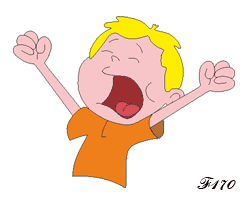 |
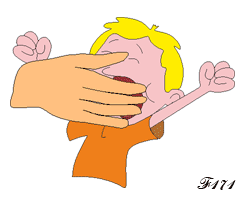 |
What nature can do, |
education can forbid. |
Gradually, researchers have recognised that children know much more than they thought they did, but above all that they add to their knowledge in a scientific way, by experimenting, using statistics, and formulating hypotheses in all the areas they explore.
f – Education - Adult-directed learning for the child :
What then would be the best way for the child to exploit its extraordinary possibilities ?
The great thinkers of education, such as Montaigne, Comenius, William James developed their theories with the only means of exploration available to them at the time : introspection, observation, or dialogue, which could have led them astray, as was the case for Jean Piaget.
These great thinkers were like children, who we know today discover things by trial and error [cf : "a - Handling objects"].
However, the brain begins to learn in utero : hearing and smell are already functional, and it memorises sounds and smells.
Thanks to hearing, the cerebral network dedicated to language is activated from the first months of life. The seat of speech is already present in the left hemisphere. The sense of number is also very early, since it is observed in newborns a few hours old.
The parietal area responsible for this allows the child to develop mathematical intuition immediately, which shows the importance of the latter in evolutionary choices. It is also the area that will be involved in the brains of the great mathematicians, as they practice their discipline.
However, none of these abilities would flourish without an indispensable function : curiosity.
In evolved species, knowledge of the environment is necessary for reasons of survival. It is expressed in the desire to learn, which involves an ancient circuit in the evolution of species : the dopaminergic system, which directs attention to new but understandable phenomena. Curiously, the effect observed is comparable to that caused by a drug.
In this parietal area, reading and calculation call upon distinct regions : the language region will later be used for reading, the calculation region will allow the use of tools. For example, the brain activity of children watching a television programme will differ depending on whether the programme offers games with letters or numbers.
It is important to let children use their natural abilities. It has also been found that, later on, a teacher's lesson in which the child remains passive is less effective than pedagogies in which he or she can intervene freely with questions or experiment on their own.
This principle was used by Google to develop an algorithm that enables a robot to improve its learning.
Writing, a combination of image, sound and gesture :
Writing, a combination of image, sound and gesture :
The written word is a recent conquest of humanity. It appeared only five to 6,000 years ago and has not had time to transform the brain in the same way as oral language has.
We have seen that learning to read only began with the development of education over the last few centuries.
Another difficulty is the multiplicity of languages and orthographic systems, which excludes any possibility of harmonising a genetic coding.
Thus, unlike oral language, which is acquired spontaneously, written language requires learning by a teacher.
What capacities does the child have to assimilate this teaching ?
These abilities, which are the same for all children, are of three kinds :
- Phonological awareness which is the ability to manipulate speech as an object and which enables the child to perceive, cut up and manipulate the sound units of language (phonemes, syllables, etc...).
- the recognition of letter names and their pronunciation, which children are confronted with from the age of three or four. They will detect certain regularities, such as the orientation of words in space or their length. They will also discover that these words are composed of different and recurring signs.
- awareness that the written word does not directly associate the object (a hen for example) with its spelling form.
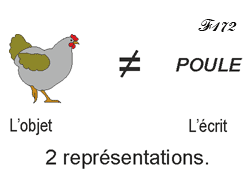
This awareness is achieved through the oral form. It is the use of the alphabetic system that forms the basis from which children learn to associate letters and sounds.
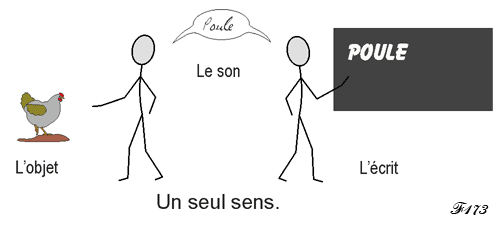
Deciphering remains hesitant for a long time, until memorization allows rapid recognition and a certain fluidity in word recognition.
From now on, the meaning of the words will be automatically linked to the perception of the written words and, in the same way, the hearing of the words will activate the orthographic forms already stored in memory.
The end result is the establishment of new circuits in the brain, and the reorganisation of its functioning. Children will then have an external data bank to facilitate their learning.
Effects of learning on the brain :
The brain is built outside the child's 'will'. The first learning was limited to exploiting innate capacities, including a capacity for abstraction that allows memorisation and anticipation of situations.
Later, learning will reorganise the brain according to more abstract criteria, such as representing objects in words, and representing volumes or weights by calculation.
For this, the architecture of the brain will change.
- At the macroscopic level, and on an evolutionary scale, this brain architecture is very stable : we observe large bundles of connections, identical in all human beings, whatever their culture or access to education.
The development of writing and mathematics did not have time to cause major changes.
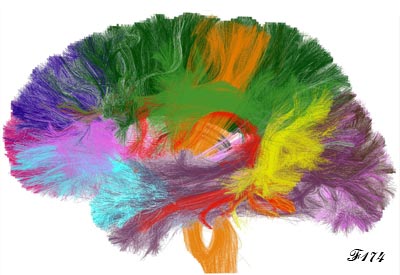
Representation of 38 long bundles of white matter in the brain
(each bundle is represented by a different colour).
CEA/Neurospin
(each bundle is represented by a different colour).
CEA/Neurospin
- On the millimetre scale, on the other hand, individuals are all different, and the impact of learning is reflected in significant modifications. For example, in a literate person, the nerve fibres are more myelinated, which leads to a greater speed of conduction in the axon bundles that link the visual and language areas.
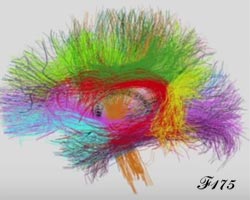 |
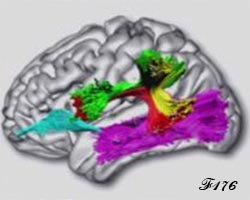 |
On diffusion MRI, a significant change in the cortical white matter bundles was found.
The posterior segment of the arcuate bundle (in yellow) is better structured in readers.
The posterior segment of the arcuate bundle (in yellow) is better structured in readers.
- Finally, at the microscopic level, learning modifies all the connections between neurons, showing that the knowledge acquired is incorporated into the brain tissue as well as into the genes [see : Memory - in french].
The researchers were able to scan the brains of children before and after they began learning to read. They found that the reading area, located in the "visual word form area", was activated by the sight of written letters and words more than by any other image. This suggests that learning to read redirects the function of this area of the brain.
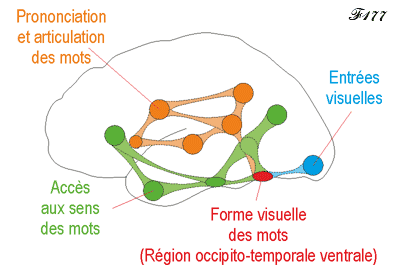
The regions in orange and green are activated for both reading and language.
La lecture modifie également une région qui permet d’identifier les phonèmes : le planum temporale, proche de l’aire auditive primaire.
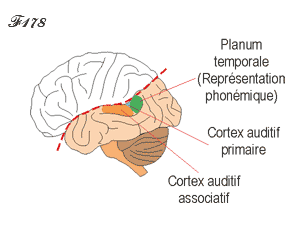 |
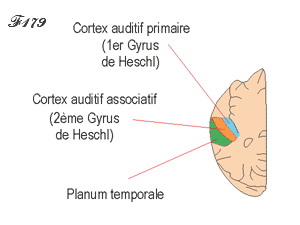 |
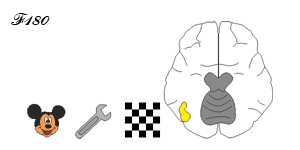
The Visual Word Form Area (VWFA) is activated by faces as well as by objects and checkerboards, before learning to read redirects its function.
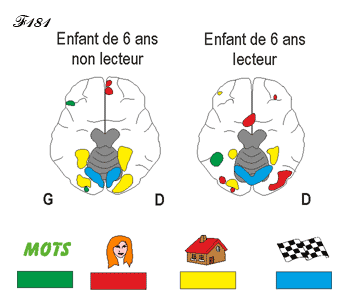
In two children of the same age, but of unequal learning, we observe the activation of the visual word form area in the reader.
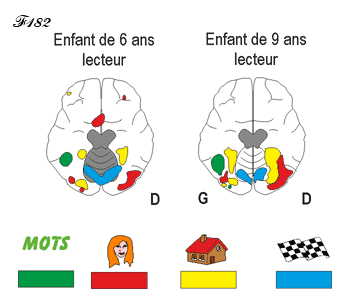
s reading improves, face recognition decreases in the left hemisphere and increases in the right hemisphere.
This area of written word recognition, transformed by learning to read, is genetically encoded and can be found in other animal species such as the macaque monkey.
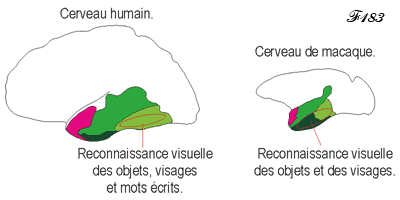
What is the basis for the child's learning, before it is guided by adult knowledge ?
We thus discover that, far from being incomplete adults, babies and young children are true scientists who explore the world, understand, innovate and transform themselves.
This curiosity, which is independent of any value judgement and is found throughout the animal kingdom, appears in its purest form from the very first years of children's lives.
Later, however, their curiosity and awareness of reality will fade as adults.
Indeed, the capacities required for the adult to act effectively require a properly pruned brain network and the acquisition of automatisms. These characteristics are not compatible with the qualities needed to learn and adapt to all new situations. This is what will determine the difference between the child and the adult he or she will become.
The child's behaviour reveals the very functioning of consciousness.
However, if the child left to his own devices proves to be more 'intelligent' than the child subjected to a formal education, and if his creativity distinguishes him from those who are stuck in the collective mould, the counterpart of this freedom could be a certain social maladjustment.
It is this apparent opposition between two complementary systems (adaptation and automatism) that determines man's entry into a third period of his life, that of objective consciousness.
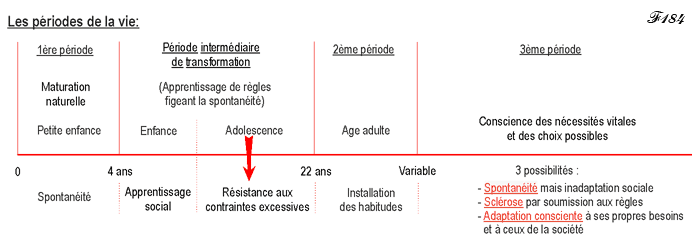
«The child possesses the intelligence that allows him to understand and adapt.
The adult acquires the automatisms that facilitate his adaptation to the conditions of the environment.»
The adult acquires the automatisms that facilitate his adaptation to the conditions of the environment.»
5 - The child, from dependence to autonomy : (continued)

